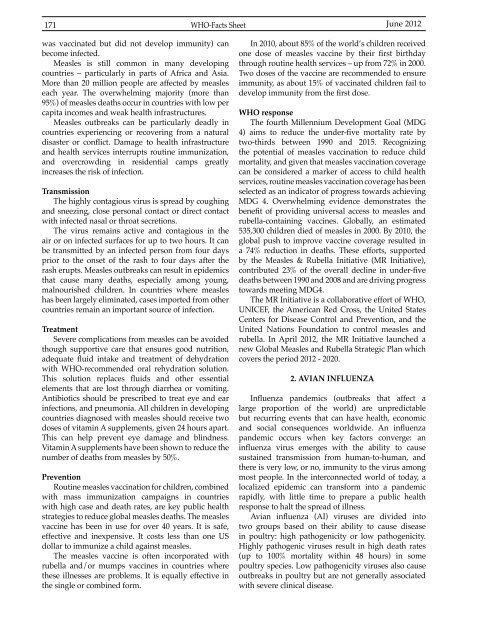Vol 44 # 2 June 2012 - Kma.org.kw
Vol 44 # 2 June 2012 - Kma.org.kw
Vol 44 # 2 June 2012 - Kma.org.kw
Create successful ePaper yourself
Turn your PDF publications into a flip-book with our unique Google optimized e-Paper software.
171<br />
WHO-Facts Sheet <strong>June</strong> <strong>2012</strong><br />
was vaccinated but did not develop immunity) can<br />
become infected.<br />
Measles is still common in many developing<br />
countries – particularly in parts of Africa and Asia.<br />
More than 20 million people are affected by measles<br />
each year. The overwhelming majority (more than<br />
95%) of measles deaths occur in countries with low per<br />
capita incomes and weak health infrastructures.<br />
Measles outbreaks can be particularly deadly in<br />
countries experiencing or recovering from a natural<br />
disaster or conflict. Damage to health infrastructure<br />
and health services interrupts routine immunization,<br />
and overcrowding in residential camps greatly<br />
increases the risk of infection.<br />
Transmission<br />
The highly contagious virus is spread by coughing<br />
and sneezing, close personal contact or direct contact<br />
with infected nasal or throat secretions.<br />
The virus remains active and contagious in the<br />
air or on infected surfaces for up to two hours. It can<br />
be transmitted by an infected person from four days<br />
prior to the onset of the rash to four days after the<br />
rash erupts. Measles outbreaks can result in epidemics<br />
that cause many deaths, especially among young,<br />
malnourished children. In countries where measles<br />
has been largely eliminated, cases imported from other<br />
countries remain an important source of infection.<br />
Treatment<br />
Severe complications from measles can be avoided<br />
though supportive care that ensures good nutrition,<br />
adequate fluid intake and treatment of dehydration<br />
with WHO-recommended oral rehydration solution.<br />
This solution replaces fluids and other essential<br />
elements that are lost through diarrhea or vomiting.<br />
Antibiotics should be prescribed to treat eye and ear<br />
infections, and pneumonia. All children in developing<br />
countries diagnosed with measles should receive two<br />
doses of vitamin A supplements, given 24 hours apart.<br />
This can help prevent eye damage and blindness.<br />
Vitamin A supplements have been shown to reduce the<br />
number of deaths from measles by 50%.<br />
Prevention<br />
Routine measles vaccination for children, combined<br />
with mass immunization campaigns in countries<br />
with high case and death rates, are key public health<br />
strategies to reduce global measles deaths. The measles<br />
vaccine has been in use for over 40 years. It is safe,<br />
effective and inexpensive. It costs less than one US<br />
dollar to immunize a child against measles.<br />
The measles vaccine is often incorporated with<br />
rubella and/or mumps vaccines in countries where<br />
these illnesses are problems. It is equally effective in<br />
the single or combined form.<br />
In 2010, about 85% of the world’s children received<br />
one dose of measles vaccine by their first birthday<br />
through routine health services – up from 72% in 2000.<br />
Two doses of the vaccine are recommended to ensure<br />
immunity, as about 15% of vaccinated children fail to<br />
develop immunity from the first dose.<br />
WHO response<br />
The fourth Millennium Development Goal (MDG<br />
4) aims to reduce the under-five mortality rate by<br />
two-thirds between 1990 and 2015. Recognizing<br />
the potential of measles vaccination to reduce child<br />
mortality, and given that measles vaccination coverage<br />
can be considered a marker of access to child health<br />
services, routine measles vaccination coverage has been<br />
selected as an indicator of progress towards achieving<br />
MDG 4. Overwhelming evidence demonstrates the<br />
benefit of providing universal access to measles and<br />
rubella-containing vaccines. Globally, an estimated<br />
535,300 children died of measles in 2000. By 2010, the<br />
global push to improve vaccine coverage resulted in<br />
a 74% reduction in deaths. These efforts, supported<br />
by the Measles & Rubella Initiative (MR Initiative),<br />
contributed 23% of the overall decline in under-five<br />
deaths between 1990 and 2008 and are driving progress<br />
towards meeting MDG4.<br />
The MR Initiative is a collaborative effort of WHO,<br />
UNICEF, the American Red Cross, the United States<br />
Centers for Disease Control and Prevention, and the<br />
United Nations Foundation to control measles and<br />
rubella. In April <strong>2012</strong>, the MR Initiative launched a<br />
new Global Measles and Rubella Strategic Plan which<br />
covers the period <strong>2012</strong> - 2020.<br />
2. AVIAN INFLUENZA<br />
Influenza pandemics (outbreaks that affect a<br />
large proportion of the world) are unpredictable<br />
but recurring events that can have health, economic<br />
and social consequences worldwide. An influenza<br />
pandemic occurs when key factors converge: an<br />
influenza virus emerges with the ability to cause<br />
sustained transmission from human-to-human, and<br />
there is very low, or no, immunity to the virus among<br />
most people. In the interconnected world of today, a<br />
localized epidemic can transform into a pandemic<br />
rapidly, with little time to prepare a public health<br />
response to halt the spread of illness.<br />
Avian influenza (AI) viruses are divided into<br />
two groups based on their ability to cause disease<br />
in poultry: high pathogenicity or low pathogenicity.<br />
Highly pathogenic viruses result in high death rates<br />
(up to 100% mortality within 48 hours) in some<br />
poultry species. Low pathogenicity viruses also cause<br />
outbreaks in poultry but are not generally associated<br />
with severe clinical disease.
















